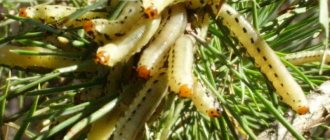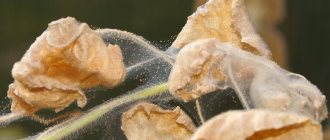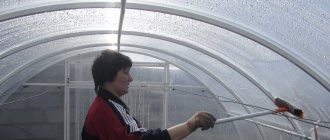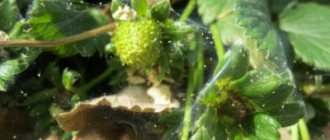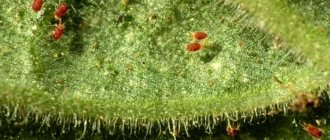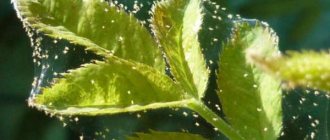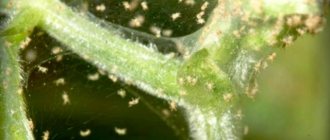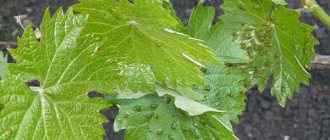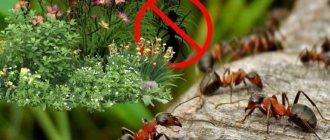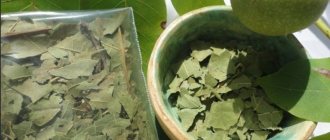The presence of spider mites can often be detected only by the changed appearance of plants: their leaves begin to turn yellow, dry out and fall off. The parasite can move to your flowers from contaminated soil or get in with the wind through a window or vent. Proven folk methods will help you get rid of pests.
Laundry soap
For a liter of water you will need 20-30 g of laundry soap. It must be thoroughly dissolved in the liquid and a thick foam must be formed. All infected plants must be soaped and left in this state for a couple of hours. The top layer of soil in pots should also be treated.
After the specified time, it is recommended to cover the soil with film, then rinse the flowers and leave them in the bathroom. The layer of soil treated with soap is removed and replaced with a new one. This procedure must be carried out up to 5 times until the spider mites disappear completely. Curtains also need to be washed, as pests can temporarily move onto them.
How to detect
The spider mite is very small in size, making it extremely difficult to see with the naked eye. The largest adult individuals have a body length of no more than 5 mm. Depending on the species, the insect may have different colors. Most often you can find green ticks, but they also come in orange or red.
These pests can hide in the soil, in a flower pot, or in the leaf axils of a plant. If there are a lot of ticks, then it will not be very difficult to notice them.
Signs of spider mites
If this pest has settled on your indoor plant, then light and pale yellow spots will form on the entire surface of its leaf blades. If there are a lot of pests, then examining the underside of the leaves, you can see a thin web on it. If the flower is completely covered with cobwebs, it will dry out quickly.
Onion
Onion infusion is prepared in the following way: 500 g of husk is poured into 5 liters of water and infused for five days. The finished product is diluted with a large amount of water, after which it is poured into a spray bottle and the affected plants are thoroughly sprayed.
Another method involves preparing the drug directly from the bulbs. Two finely chopped onions are dipped in a liter of hot water and left for 30-40 minutes. The resulting product must be filtered and diluted with water. Treatment is carried out through spraying.
Recipes
There are traditional methods of fighting spider mites. We present to you several effective recipes for homemade decoctions and infusions against ticks.
Soap solution
It can be used on both indoor greenhouse plants .
For processing in a greenhouse you will need a concentrated soap solution.
In a bucket of warm water, dilute 200 grams of laundry soap , crushed on a coarse grater.
The resulting solution is infused for 2-3 hours, mixed well and sprayed on the infected plantings. Instead of soap, you can use dishwashing detergent diluted in water.
Indoor plants are wiped with a sponge well soaped with laundry soap. Particular attention is paid to leaves and stems. Be sure to process the pot and lightly spray the soil around the plant.
It is important not to let the soap solution get on the roots , as this can lead to the death of the flower.
The treated plant is left for 3-4 hours , then the soap suds are washed off and covered with a plastic bag for a day to maintain high humidity.
Sulfur-tar soap for spider mites is a fairly effective and proven remedy. Add 100 grams of crushed sulfur-tar soap to a bucket of water and spray it weekly. This treatment is repeated 2-3 more times.
Suitable for both indoor and garden plants. After such treatment, the spider mite is guaranteed to disappear .
Alcohol solution
Ammonia is used . A solution of ammonia is made at the rate of 30 ml per bucket of water (10 l). This product can be used to wipe leaves and treat the greenhouse.
A soap-alcohol solution is also used on indoor plants. Dissolve 20-30 grams of soap in 1 liter of boiling water, cool and pour in 10-20 ml of alcohol. Carefully process the plant and top layer of soil.
Garlic
With its help you can make several types of infusion :
- Grind 30 grams of garlic , add a bucket of hot water and leave for a day. The finished infusion is filtered and the affected leaves are treated.
- You can finely chop 500 grams of garlic , add 3 liters of water and leave in a dark place for 5-6 days. Then strain the infusion, pour 60 grams and dilute it in a bucket of water. You can add 50 grams of laundry soap there.
- Chopped garlic (200 g) is stirred in a bucket of water and sprayed immediately , without infusion.
- There are situations when a houseplant does not tolerate spraying (for example, succulents). In this case, chopped garlic is placed in a small container, placed next to the plant and the whole thing is covered with a bag for 1-2 hours .
Onion
Onion infusion also helps well in the fight against ticks. To prepare it, you need to 200 grams of fresh onion peel into a bucket of well-warm water and put it in a warm place for 12 hours. The resulting infusion is filtered, squeezed and sprayed on the plants.
For indoor plants, you can simply wipe the leaves and stems . The procedure is carried out weekly for 1-2 months.
Decoctions and infusions of herbs
Dandelion also helps a lot in the fight against ticks. To do this, 30-40 grams of medicinal dandelion roots are crushed and poured with a liter of water. The plant is left to infuse for several hours and processed.
A decoction of cyclamen roots saves indoor plants. Boil 50 grams of roots in 0.5 liters of water and filter. The resulting decoction can be used to wipe the leaves and stems. After 5 days, the procedure is repeated.
The yarrow infusion is prepared as follows: 700-800 grams of dry leaves are infused in 10 liters of boiling water. After 3 days, it can be used to treat both greenhouse and indoor plants.
An infusion of potato tops also helps a lot against spider mites: 1 kg of fresh tops is crushed and filled with a bucket of water.
Leave for 3-4 hours and filter. Can be used for greenhouse treatment.
Infusion and decoction of black henbane . This plant is extremely poisonous, but if you are careful, you can get rid of the tick forever.
To infuse, pour 1 kg of henbane into a bucket of water and leave for 10 hours. Then strain and add 20 grams of laundry soap. You can take 2 kg of fresh henbane, add water and cook for 2-3 hours. After filtering, add 10 liters of water to the broth.
Horseradish infusion : 1 kg of finely chopped horseradish roots is poured into a bucket of cold water. Leave for several hours and treat the plants.
A decoction of gray alder leaves is prepared from 2 kg of fresh leaves filled with a bucket of water. It is infused for 24 hours, then it is boiled for half an hour and infused again for 12-13 hours.
Wormwood decoction helps not only in the fight against ticks, but also against many other pests. Add 800 grams of dry wormwood to a bucket of water and leave for 2 days. Then cook for half an hour, filter and add another 10-12 liters of water.
This decoction is good for spraying greenhouse plantings.
Garlic
For a liter of warm water you will need two finely chopped heads of garlic. The product should be infused for five days. After this, it is filtered, diluted with water in a 1:1 ratio and the plants are treated.
Most often, housewives prefer to spray them with a solution poured into a spray bottle, but you can wash the affected flowers or wipe the large leaves of some of them.
If green pets do not tolerate spraying (for example, succulents), then chopped garlic should be placed in a saucer, placed next to a flower pot and cover both containers with a bag for a couple of hours.
Prevention of infection
To prevent plants from being damaged by spider mites, preventive measures should be taken:
- systematically inspect all indoor plants;
- this pest prefers dry air, so it is important to maintain an optimal level of humidity;
- it is necessary to systematically spray the leaf plates from a sprayer with clean water;
- Once a month the flower needs a warm shower;
- recently purchased flowers must be quarantined;
- Be sure to steam the substrate, as it may contain individuals that hibernate in the ground.
Yarrow
You can also poison spider mites using herbal infusions. For example, a product based on yarrow is prepared as follows: 500-600 g of dry herb are brewed in a liter of boiling water.
The finished broth is diluted with water, bringing it to a volume of 10 liters, and then infused for three days. After this, the drug can be used to treat plants.
Infusions of celandine or dope are prepared in a similar way - these herbs have an equally effective effect on pests when fighting them.
In the greenhouse
How to deal with spider mites in a greenhouse? To prevent ticks from appearing, you need to start with prevention :
- regularly weed and loosen the soil in the greenhouse;
- alternate planted crops annually
- after harvesting, in the fall, carefully dig up the soil in the greenhouse;
- maintain high humidity ;
- regularly water the plants and mulch the soil around them;
- Inspect the undersides of leaves for white or yellow spots or spider webs. Affected leaves are plucked and burned.
It is better to use chemicals in a greenhouse as a last resort if folk remedies do not help. Recipes for homemade decoctions and infusions have been tested for centuries, and it is not for nothing that they are still used in pest control.
If the spider mite has settled in the greenhouse, then it’s time to carry out treatment . The fight against spider mites in a greenhouse with folk remedies is that you can simply dig up and burn the affected plants, but it is better to try regular spraying with homemade solutions. For greater effectiveness, you can alternate different means.
Apple vinegar
To prepare the product, add 30 ml of apple cider vinegar to 10 liters of water. For better adhesion to plant leaves, add 100 g of laundry soap to the solution.
Having brought the consistency of the drug to homogeneity, treat the affected flowers with it by spraying or wiping. It is necessary to carry out 3-4 treatments to completely get rid of spider mites and prevent their reappearance.
Spider mite: insect appearance
To successfully combat a pest, you need to make sure that this insect is a spider mite. To do this it should be noted:
- The common spider mite is an arachnid insect belonging to the category of arthropods. Has two pairs of eyes;
- has no whiskers or wings, the legs are formed from five segments;
- length from 0.2 to 1 mm;
- colors - red, green-yellow or orange;
- The mite lives on the lower parts of the leaf, where it weaves a web. You can notice the pest by tiny dots on the leaves of cucumbers.
Spider mites are characterized by rapid reproduction. A female tick lays up to 450 eggs per day. A tick lives for at least 35-55 days. With almost one hundred percent hatchability, offspring are born. The cubs grow up quite quickly and, in turn, lay eggs, which they hide in the intricacies of the web.
Important! At temperatures from 23 to 31 degrees and humidity from 40 to 65%, the most optimal microclimatic conditions for the offspring arise.
Signs and how to recognize mites on roses
This insect is so small that it can be very difficult to recognize it on the lacy leaves of rose bushes. This can only be done with a magnifying glass. You can detect a mite with the naked eye when it grows in size, but most often at this stage it is no longer possible to save the flowers. The mite prefers to live and reproduce on the underside of the leaf. The tick family grows very quickly - the number of colonies can reach several hundred voracious individuals.
The areas of parasitic influence of the mite are covered with white spots - it is their presence that should alert and suggest that the rose has been damaged by a mite. Over time, these spots grow, and the axils of the leaves become entangled in a thin whitish web. The affected leaves turn yellow, dry out and then fall off. If no measures are taken, the web can completely envelop the bush, including the buds, which become mummified and then fall off. When increased many times over, the population appears as a large teeming mass of red color. In this case, the plant may completely lose its leaves and flowers, and the stem will be covered with a strong thread of cobwebs. Such a bush will have to be dug up and destroyed.
By the way! Indoor roses are especially susceptible to mite attacks.
What is a pest
Spider mites are small pests that cause damage to many crops. It is classified as an arachnid. Pepper is attacked by the most common variety - ordinary.
Spider mite on pepper.
What does a parasite look like?
Female spider mite.
Spider mites have miniature sizes and an ellipsoidal shape. The body of females is from 0.4 to 0.6 mm, and that of males is from 0.3 to 0.45 mm. The coloration of sexually mature parasites can be:
- dark green;
- greenish-gray;
- yellow.
Fertilized females change color to orange-red.
What does it eat?
Spider mites pierce the epidermis of leaves. The pest sucks out all the juice, disrupting the formation of the pepper. An enzyme contained in saliva breaks down chloroplasts. The leaves dry out and begin to die.
Parasites feed on more than just peppers. They also attack:
- eggplant;
- tomatoes;
- cucumbers;
- various flowers.
How does it reproduce
Masonry
One clutch contains more than several hundred eggs. They have a spherical shape. The eggs are greenish in color. At the final stage of development they can be compared to pearls.
Larvae
The larvae hatch after 25 days. The larvae are light green or greenish-brown in color. There are dark spots on both sides.
Life cycle
The life cycle ranges from 30-50 days. Wintering places are foliage, greenhouse crevices, tree bark. Only eggs and females overwinter. The optimal temperature range is from 25 to 27 degrees.
Chemical methods
If insects cannot be controlled with folk remedies (or you started the fight too late), chemical methods should be used. But you need to use them extremely carefully so as not to damage the plants and not get poisoned yourself.
Plant Pin
It destroys not only adults, but also their eggs.
The drug looks like special sticks. We will poison ticks like this:
- take a stick and stick it into the ground at a distance of 2 centimeters from the stem (this should be done on each plant);
- water the plant.
After this, the plant pin will be absorbed into the ground. Insects will feel the effect of the drug within a few days. Usually they talk about two days, but most often you need at least 3-4 days.
Fitoverm
One treatment is enough for spider mites to immediately stop reproducing. But the remedy is suitable only when there are still few insects.
How to use:
- pour 2 liters of water into a bucket;
- open the ampoule of the drug and mix it in a bucket;
- then pour more water and mix thoroughly again;
- pour the resulting mixture next to the plants.
Aktellik
The drug is poisonous to humans, so you need to wear gloves, a protective mask and a reliable headgear. If possible, wear protective clothing. You can use a robe. When diluting the drug, act only strictly according to the instructions. It is forbidden to deviate from it.
At the same time, Candidate of Agricultural Sciences Tatyana Steinert says that due to its toxicity, the drug is now used mainly in industrial greenhouses.
Actellik is used as follows:
- dilute the drug in a small amount of water;
- bring the emulsion concentration to 1 mm per 1 liter. working solution;
- Apply the resulting solution generously to the plant leaves.
What kind of soap is there anyway?
For the garden we use three types of soap. Most often, ordinary household items. However, there are other options - tar and green.
- Laundry soap, or Marseilles soap , is cheap and cheerful: if it gets on insects, it leads to their death. It has antibacterial and antifungal properties, contains fatty acids (no more than 76%) and free alkalis (pH 11-12).
- Tar soap - soap with birch tar (up to 10%). This is a milder product with less alkali and a higher fatty acid content. The main application is cosmetology, as an antiseptic, regenerating and medicinal product.
- Green or potassium soap is sold in specialized stores for treating plants. It consists of water, natural fats, vegetable oils and potassium salts of fatty acids (hence the second name of soap - potassium). Sold in the form of a gel or spray. Can be used immediately to treat plants. The spray does not require preparation or dilution. The gel is diluted in water.
BUT, not all advice from the Internet on using soap in the garden can be used. So, let’s look at the use of laundry soap, as the most popular and affordable one, in a summer cottage. Where it should be used and where not.
Sprinkling
At the initial stages of infection, mechanical control methods cope well with infection, the simplest and most harmless of which is sprinkling. Most plants respond well to this procedure in the warm season, while the ideal conditions for spider mites are dry air.
To prevent disease, periodic sprinkling can be done. The parasite, along with drops of water, will fall to the ground, where it will die within a few days. This primitive technique helps stop the spread of arachnids in dachas.
Purchased drugs
Acaricides are a special kind of preparations of chemical or biological origin, the action of which is aimed at destroying ticks. In the fight against arthropod pests that have settled on indoor plants, two groups of such agents are used.
- Specific acaricides. They are made on the basis of sulfur, nitrogen, bromine. They mainly act only against ticks.
- Insectoacaricides. They work due to the organic sulfur contained in the composition, some types of pyrethroids, and organophosphorus compounds. Kill ticks and other insects.
Principles of application
A tenacious tick quickly adapts to toxic substances, so it is recommended to use different drugs alternately to ensure pest control is as effective as possible. Experienced gardeners advise changing the product every two to three uses. Therapy with purchased drugs must obey five rules.
- Observe safety precautions. Wear clothing that completely covers the body, rubber gloves, a headscarf, preferably a respirator and goggles. Carry out the treatment in a well-ventilated area with the windows open, or even better - on the balcony. If the toxicity of the drug is higher than class three or four, it can only be used outdoors. After treatment, wash your hands, face, rinse your mouth, and wash your clothes.
- Protect the root. Before processing, cover the root zone of the flower and the soil with plastic wrap or a plastic bag.
- Follow the recommendations. When processing plants, strictly follow the instructions included with the preparation.
- Take solar activity into account. During processing and until the plant is completely dry, the flower should not be exposed to direct sunlight. It is recommended to carry out the procedure up to 12 hours, in cloudy weather - up to 14.
- Start with less toxic drugs. First you need to test a product of biological origin, then, if necessary, move on to stronger chemical products, and only as a last resort resort to “heavy artillery”: agents of increased toxicity.
Technology
Most store-bought preparations are used in the same way: the product must be diluted with water, following the recommendations described in the instructions, and then used to spray plants. Typically, three to five treatments are required, spaced five to eight days apart.
Some manufacturers produce the product in spray form, which greatly simplifies processing.
Drugs
First of all, you need to use biological agents. Their main advantage is relative safety for humans, but some compounds are harmful to pets. The table below reveals the specifics of purchased drugs of biological origin.
Table - Overview of biological agents
| Name | Specifics |
| "Akarin" | - Do not mix with other drugs; - has a good reputation among flower growers |
| "Bitoxibacillin" | — May provoke an allergic reaction upon contact with the treated plant; - contains wetting agents and adhesives that facilitate pest control |
| "Fitoverm" | — Wide spectrum of action; — low efficiency at temperatures below 18°C; - unpleasant odor; - does not work on roses; — red spider mites are resistant to the drug |
| "Kleschevit" | — Does not cause addiction among pests; — red spider mites are resistant to the drug |
If the use of biological agents does not produce results, you can resort to chemical products of the fourth toxicity class and stronger compounds such as Sunmite or Neoron. And only in case of emergency, use Vertimek, Karbofos or Actellik. The table below will help you get an idea of the most popular products of this kind.
Table - Overview of chemicals
| Name | Toxicity class | Peculiarities |
| "Neoron" | 3 | — Persistent unpleasant odor; - has an ovicidal effect (destroys eggs); — one treatment is required every 30-40 days |
| "Nissoran" | 4 | — Destroys larvae and eggs; — sterilizes adult parasites, but does not kill them; - compatible with other drugs and is most often used in combination with them |
| "Omite 30 and 57" | 2 | — Does not cause addiction in the pest even with prolonged use; - specific smell |
| "Sunmite" | 3 | — Used once a year, as parasites quickly adapt to the drug; - has no smell; - affects both larvae and adults |
| "Demitan KS" | 2 | — Effective against mobile stages of ticks and summer eggs; - economical to use |
| "Apollo" | 4 | — Used to combat larvae and eggs; — does not kill adult parasites, but sterilizes females; - most often used in combination with other drugs |
| "Aktellik" | 2 | — In Russia, the drug has not been registered for individual use since 2016, but is sometimes found on sale in small stores; - used only outdoors; — re-treatment is required after 4-5 days; — more than 2 treatments in a row should not be carried out so that the tick does not adapt to the action of the drug |
| "Karbofos" | 3 | — Strong unpleasant odor; - used only outdoors; |
| "Vertimek" | 2 | — Used outdoors only; - inactive against red spider mites |
LiveInternetLiveInternet
—Tags
—Categories
- Adobe After Effect (1)
- (0)
- memories (3)
- embroidery (10)
- knitted toy (108)
- knitted shoes (393)
- knitting for children (763)
- knitting for men (68)
- knitting border, patterns. knitting recommendations (362)
- crochet (5323)
- crochet tops, tank tops, hats, bolero (772)
- crochet for home, bags, napkins, angels, (254)
- knitting with fur (5)
- crocheted dresses, sundresses, suits (1169)
- crocheted jackets, jumpers, blouses, sweaters, pullovers (1400)
- crocheted tunics, cardigans, sleeveless vests, coats (713)
- knitted skirts, necklaces, flowers...pancho. (138)
- hook+knitting needles+fabric (137)
- patchwork knitted (4)
- knitting (5740)
- cardigan, tunic, coat (1092)
- knitted trousers (3)
- knitting trim (98)
- dress, suit, skirt (350)
- knitting selection (6)
- pullover, jumper, top, blouse, jacket, sleeveless vest (3436)
- napkins, tablecloth knitted (4)
- shawl, hats, slippers, gloves, socks, knitting patterns (507)
- knitting: large sizes (12)
- knitting:knitting magazines (185)
- horoscope (25)
- dacha (1112)
- vegetable garden (757)
- advice to summer residents, share tricks (217)
- tomatoes (156)
- feeding vegetables (117)
- cucumbers (109)
- diseases and pests of vegetables (95)
- green manure, fertilizers, mulch (87)
- fertilizing and combating garden diseases (84)
- seedlings (78)
- bushes, trees (46)
- strawberry (43)
- bow (41)
- cabbage (36)
- garlic (26)
- potatoes (24)
- carrots (24)
- bell pepper (21)
- raspberry (17)
- beets (13)
- eggplant (11)
- melons, watermelons (5)
- currant (4)
- radishes (3)
- pumpkin (1)
- peas, beans (1)
- garden decorations (33)
- flowers in the country (138)
- diary on LiRu (640)
- animation (64)
- clipart (55)
- next button (35)
- my flash clock (22)
- video frames (4)
- emoticons (1)
- diagrams for diaries (5)
- lessons (83)
- FS (463)
- home sweet home (376)
- living creatures in the house (3)
- home renovation (8)
- home decoration (11)
- home care (107)
- flowers in the house (70)
- painting, sculpture, carving, photography (203)
- conspiracy (23)
- health (247)
- games (11)
- interesting (742)
- Irish lace (22)
- beauty (972)
- cooking (2259)
- and for dessert (96)
- alcohol (14)
- air fryer (1)
- pancakes (95)
- baked goods (657)
- snack (555)
- casserole, stew (140)
- from cottage cheese and milk (13)
- porridge (3)
- canning, winter preparations (149)
- multicooker (77)
- drinks (2)
- fish (100)
- salad (313)
- sauce (12)
- cheese (4)
- stewed vegetables (114)
- bread machine (1)
- what's on second (930)
- what's on first (28)
- landscape (12)
- master class (702)
- prayer (29)
- traditional medicine (124)
- positive (111)
- parable (17)
- psychology (62)
- DIY crafts (782)
- topiary (3)
- decoupage (2)
- beading (111)
- embroidery (7)
- make toys (6)
- from plastic bottles (1)
- kanzashi (72)
- quilling (5)
- patchwork (4)
- DIY soap (1)
- origami (1)
- newspaper weaving (190)
- patchwork (2)
- fabric painting (3)
- Romanian lace lace (2)
- Turkish needle lace (5)
- family interests (24)
- advice (302)
- poems (319)
- Feng Shui (8)
- good idea (652)
- we sew ourselves (243)
- toys (63)
- sew clothes (7)
- clothing alterations (2)
- chenille technique (1)
- sew for children (43)
- humor (27)
—Quote book
Translation of English terms in Photoshop into Russian Translation of English terms in Photoshop into Russian.
I'm a butterfly in your palms. Elinushka I am a butterfly in your palms, I flew into autumn by chance, No.
Female images in watercolors by Steve Hanks Quietly, quietly. while inhaling. by ghosts.
Cooking >How to make the perfect dough.
The most delicious and versatile caramel cream Try making caramel cream. E.
—Applications
- I am a photographer
Plugin for publishing photos in the user's diary. Minimum system requirements: Internet Explorer 6, Fire Fox 1.5, Opera 9.5, Safari 3.1.1 with JavaScript enabled. Maybe it will work - For designers
color chart for designer - always no analogues at hand
^_^ Allows you to insert a panel with an arbitrary Html code into your profile. You can place banners, counters, etc. there - Postcards
Reborn catalog of postcards for all occasions
